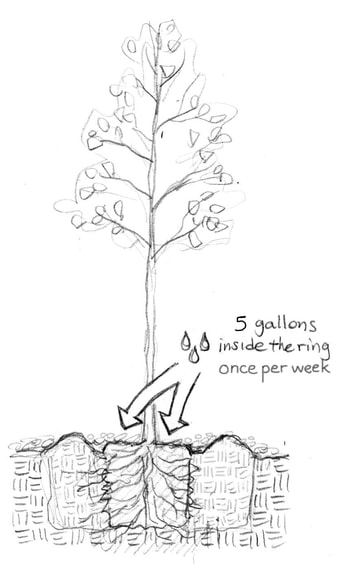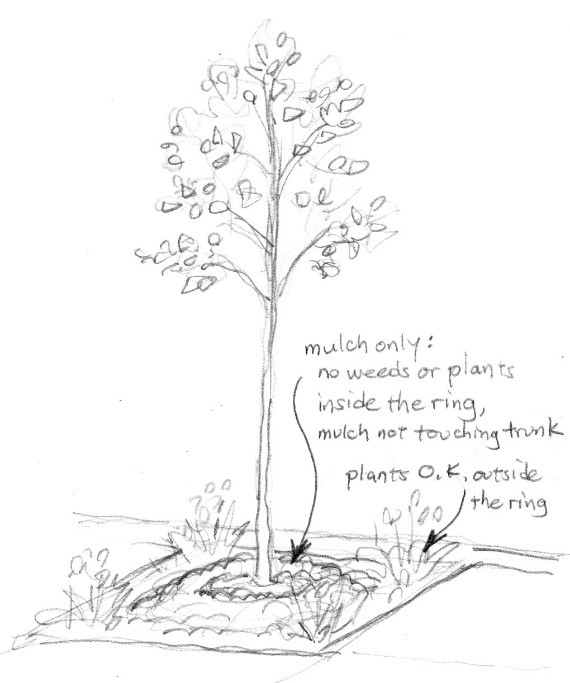Your tree is part of Oakland's urban forest, but it needs your care!
Download a tree care form here
WATERING

Even if you have a "drought-tolerant" variety, it takes at least 2 years (maybe 3) for your tree to become established. After that, your tree should not need additional watering during the dry season.
- Watering-Berm (or "ring" or "donut"):
- We have formed the soil into a raised ring (or just a "C" or "U" shape on sloping sites) to hold water at the tree's roots.
- Pour water gently inside the ring or at the uphill side of the "C", so it makes a puddle until the soil absorbs it. If the berm gets broken or you see water flowing out from a low point, please reshape the soil so it holds water again
- In past years, we would install a cardboard "watering tube" filled with pebbles next to the rootball, but these tubes didn't seem to help much so we stopped using them.
- The first day:
- Give the tree a thorough watering of at least 10 gallons of water. (If we planted the tree for you, we probably already did this.)
- Dry season (May to October):
- Give 5 gallons all at once - once per week - for 2 - 3 years -- not a little water every day. Pour it all around the trunk so all the roots get wet.
- If there is a cardboard tube, put 1 gallon down the tube and the rest around the trunk.
- Mark your calendar for the same day each week, so you don't forget.
- Even in our drought, trees are a worthy use of water; try saving the warm-up water before you shower and give it to the tree each week.
- If there was a rainy day in the past week, you can probably skip the watering this week.
- Rainy season (November to April):
- If we got at least 1/2" of rain in the past week, you can skip watering this week.
- If it has been more than a week since the last rain and the soil feels dry to you, give 2-3 gallons this week.
- Clay soil and overwatering:
- Many sites in Oakland have heavy clay soil that drains slowly, and it can harm a tree if you give it too much water.
- If you have clay soil, you may be able to water every 10-14 days instead of every week.
- Too much water can be as bad as too little. The leaves will turn brown and fall off, which might make you think you're not giving enough water, and the problem will get worse if you give it even more.
- Before you are thinking of watering again, stick your finger 2" into the ground (2 knuckles), about 12" away from the trunk of the tree. If your fingertip comes out wet/muddy, don't water again yet. Wait a couple of days.
- Many sites in Oakland have heavy clay soil that drains slowly, and it can harm a tree if you give it too much water.
MULCH
- We have put a layer of organic-rich compost and a layer of mulch (wood chips) over the rootball, like the leaf-litter in a natural forest. These layers insulate the roots from heat and cold, reduce evaporation of water, smother weeds, and provide the ingredients for healthy soil. If you see that the mulch has been disturbed, just move it neatly back into place. Don't let mulch or soil touch the base of the trunk (“root crown”), because wet bark can rot and eventually kill the tree. Just brush it away from the trunk.
WEEDS OR OTHER PLANTS
|
STAKE
- Nursery Stake:
- Trees grow better if they can sway in the wind, but that can be risky in some places. If we have left the trunk tied to its nursery stake (wood or bamboo), we think the trunk is still too thin to support its canopy or is too vulnerable to vandalism. Please don't remove it until a year has passed.
- Steel Stake:
- The screw-tipped "Reddy-Stake" is the City of Oakland's standard for supporting new trees against wind and accidental damage. The rubber or plastic strap should loosely encircle the trunk. Leave the stake on for 3 years or until the trunk of the tree is at least 3" in diameter. Please tell us when you think the tree no longer needs the stake.
- Wooden Stake(s):
- Sometimes we install 1, 2, or 3 wooden stakes near the tree (with 1 or more soft straps to loosely encircle the trunk), especially in mowed lawns, along sidewalks with heavy pedestrian traffic, or in other places where we think the tree deserves extra protection. As with the steel stake (explained above), leave the stake(s) on for 2-3 years or until the trunk of the tree is at least 3" in diameter. Please tell us when you think the tree no longer needs the stake.
- Sometimes we install 1, 2, or 3 wooden stakes near the tree (with 1 or more soft straps to loosely encircle the trunk), especially in mowed lawns, along sidewalks with heavy pedestrian traffic, or in other places where we think the tree deserves extra protection. As with the steel stake (explained above), leave the stake(s) on for 2-3 years or until the trunk of the tree is at least 3" in diameter. Please tell us when you think the tree no longer needs the stake.
PRUNING
- Every street-tree will need corrective pruning, but usually not in the first year or two.
- Do not remove every leaf or small branch sprouting from the trunk, because they are helping the tree to grow.
- If you know proper pruning techniques, you may remove suckers, prune a small broken branch, or prune a small branch that interferes with the sidewalk or street. Ask us if you want to learn how. Don't cut a big branch without getting an expert’s advice first. In theory, the City of Oakland is responsible for pruning, so please contact the City if you think your tree needs substantial pruning.
PROBLEMS
Please tell us if you see any of the following problems. Most trees do just fine, but we can troubleshoot.
- The leaves are turning yellow or brown but it isn't autumn and/or the tree isn't deciduous. It is probably a matter of too little or too much water.
- Lots of ants, aphids, or other insects are crawling on the tree, especially if they are chewing or disfiguring the leaves. We may be able to offer a diagnosis and suggest a solution. Pesticide should definitely be a last resort.
- It is May or June but the tree still doesn't have any new leaves on it. Some species naturally leaf out late, but this might be a sign that the tree is ill.
- The tree is leaning or bending a lot and you're concerned. We might restake it, splint it, or prune it.
- Low branches are blocking the sidewalk or the street. We can prune them off.
- A large branch or the main trunk is broken. We can prune it back to a clean cut or (in the worst cases) we might suggest replacing the tree entirely.
- The steel stake is damaged or missing, but we planted the tree less than three years ago. We'll replace it.
- The crossbar of the stake has become detached or broken. We'll reattach it.
- The strap or tube for the crossbar is so tight that the tree is being strangled. We'll loosen it.




